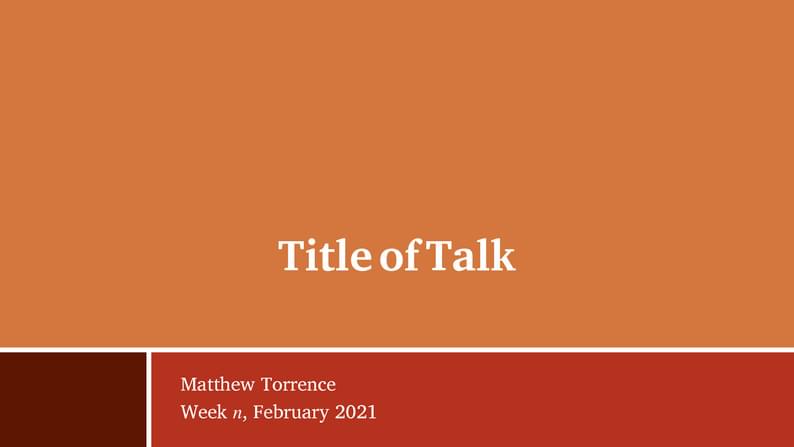
Mittens Beamer Template
Author:
Matthew Torrence
Last Updated:
5 лет назад
License:
Creative Commons CC BY 4.0
Аннотация:
V1.0 of my beamer template "mittens"

\begin
Discover why over 20 million people worldwide trust Overleaf with their work.
V1.0 of my beamer template "mittens"

\begin
Discover why over 20 million people worldwide trust Overleaf with their work.
\documentclass[aspectratio=169,usenames,dvipsnames]{beamer}
\usepackage[T1]{fontenc}
\usetheme{mittens}
% Possible color schemes: \colorschemered, \colorschemeblue, \colorschemegreen, \colorschemebrown, \colorschemepurple
\colorschemered
% Comment this line out to disable section & subsection names at the top of slides
\sectionnamestrue
% Comment this line out to remove new section slides
\sectionslidestrue
\title{Title of Talk}
\author[M. Torrence]{Matthew Torrence}
\date[2021]{Week $n$, February 2021}
\begin{document}
\titleslide
% You typically want to include "fragile" on every slide
\begin{frame}[fragile]
\frametitle{An Example Slide}
\framesubtitle{optionally with a subtitle}
\begin{block}{Definition}
This slide is showing off various elements of a slide you might want to use. Do delete this slide before presenting this template.
\end{block}
$$x = \frac{-b \pm \sqrt{b^2 - 4ac}}{2a}$$
\begin{enumerate}
\item This is an enumerated list
\item This is a second item
\end{enumerate}
\begin{itemize}
\item This is an itemized list
\end{itemize}
\end{frame}
\section{Definitions and Examples}
\begin{frame}[fragile]{What are you talking about?}
This slide is a great spot to introduce the definitions of what you will be talking about.
% The \s here is short for \vspace{1em}, which I use super often. It puts space before this paragraph, which looks very readable!
\s Let $G$ be a finite abelian group, $h$ be a non-negative integer, and $m$ be a positive integer. $\nu(G, h, m)$ is defined to be the \textit{largest size} of a $h$-fold sumset of an $m$-subset of $G$.
\s Here (or on the next slide) is a great time to go over an example of how to use this definition.
\end{frame}
\begin{frame}{Problem Statement}
Here's a good place to write down the specific problems that use the definitions you've given in the previous slide.
\s It's possible to include an example for the problem as well!
\end{frame}
\section{Results Known}
\begin{frame}[fragile]{Results known about my problem}
Here's where you can talk about what Theorems exist about whatever you've defined in the previous slides.
\s $\nu(G, h, m)$ is trivially bounded above by $|G|$... Other bounds include...
\s Be sure to reference the authors of these results, and feel free to spend more time on this part catching others up on what might be obvious to you!
\end{frame}
\section{My Results}
\begin{frame}[fragile]{My Goals}
Here it might be pertinent to remind / introduce others to what you think \textit{you} might be able to prove about your problem.
\s What assumptions do the previous results make, and do you think you can extend their techniques to lessen these assumptions?
\end{frame}
\begin{frame}[fragile]{New This Week}
Here's where you can finally talk and summarize what you did in the past week. Have you gotten closer to proving your goals?
\end{frame}
\section{Next Steps}
\begin{frame}[fragile]{Considerations and next steps}
What will you be working on in the next week? Do you have a good idea of what you will be doing, or are you stuck and looking for help?
\s Might you be able to relate what you're doing to ideas of someone else? Do you want to review another proof from the book before continuing?
\end{frame}
\section{References}
\begin{frame}{Slide Template Credit}
I (Matt Torrence) who has been speaking to you through these slides designed this template myself. Feel free to delete this slide in your presentation.
\s I was inspired by the following stack overflow response and used it as a starting point for this template: \texttt{tex.stackexchange.com/a/146682/188835}
\s Typography used includes 4 typefaces:
\begin{itemize}
\item Charis SIL, for the default serif type
\item \texttt{IBM Plex Mono} for monospace text
\item {\sansstyle Carlito} for the default sans-serif type
\item TeX Gyre Termes Math for all math mode text
\end{itemize}
\end{frame}
\end{document}